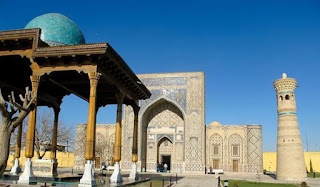Bohouddin Naqshband
Today we went to the BAHAUDDIN NAQSHBAND shrine with our students and our teacher.✨️✨️✨️✨️🏬🏬🏬🏬🤗🤗🤗🤗 Before, our teacher gave information about this. and then we immediately started the presentation Ensemble of Naqshbandi near Bukhara The Memorial Complex of Khoja Bakhouddin Naqshbandi is one of the most important Muslim shrines. Every self-respecting Muslim knows and reveres this name. The great theologian of the XIV century, founder of the Sufi Order "Naqshbandia" was buried 12 km from Bukhara in his native village of Kasri Orifon. Some time ago there was the pagan temple of the site of current tomb of Naqshbandi. Naqshbandi was the spiritual teacher of Amir Temur and made hajj to Mekka 32 times. He appealed people to be modest and rejected the luxury. His philosophy was based on the principle: "Dil ba joru, dast ba kor" ("The heart - with the God, hands at work"). The main building of the complex is the khanqah. Before the frontal of the mosque t...





